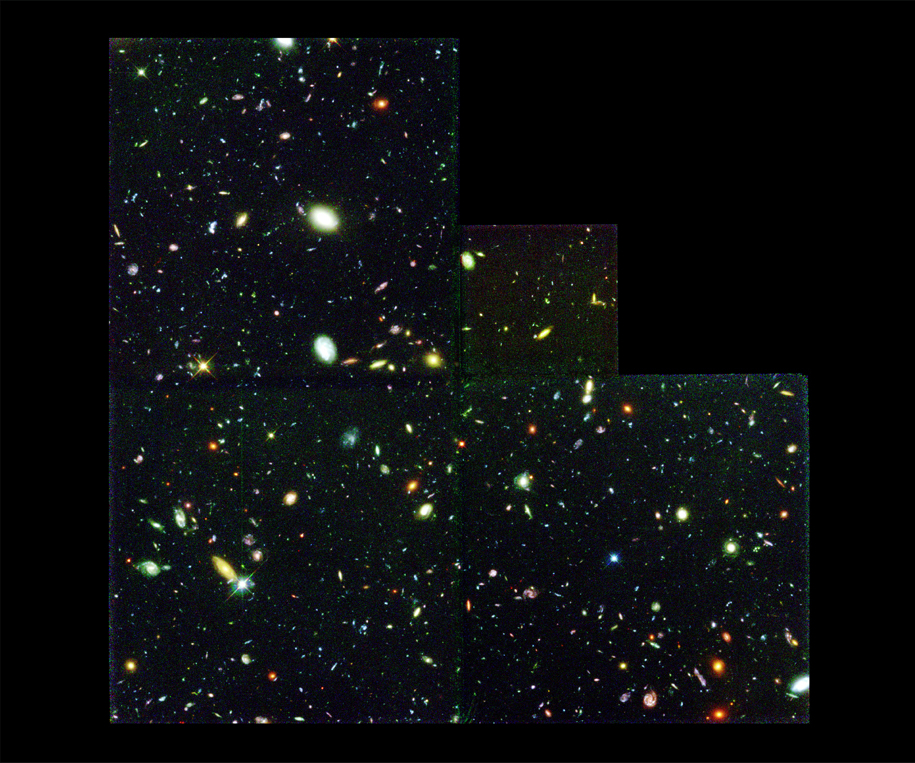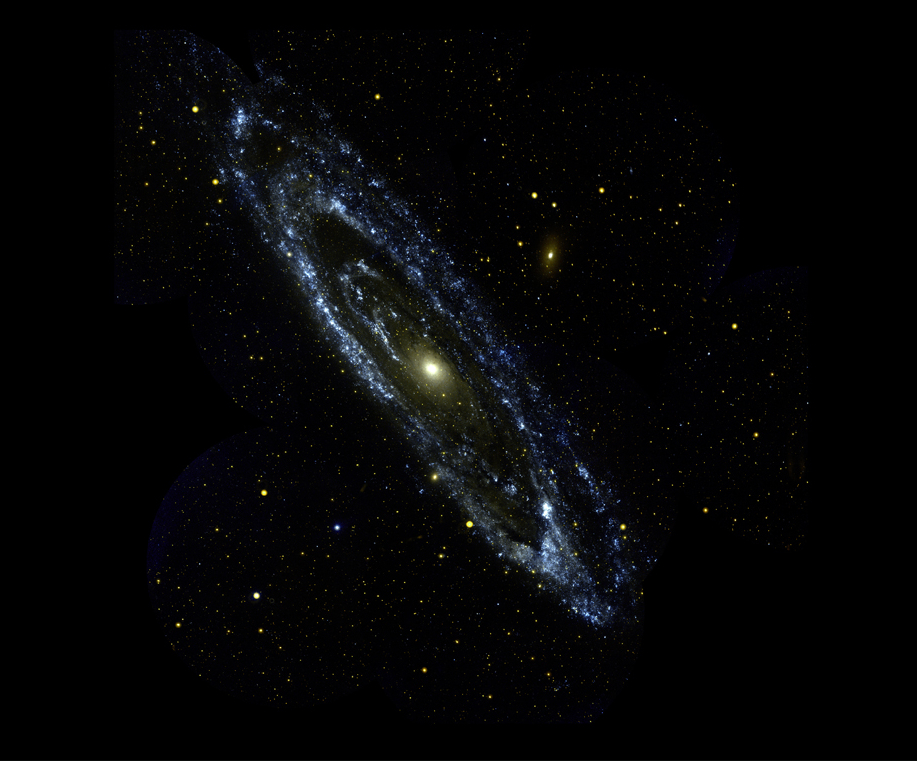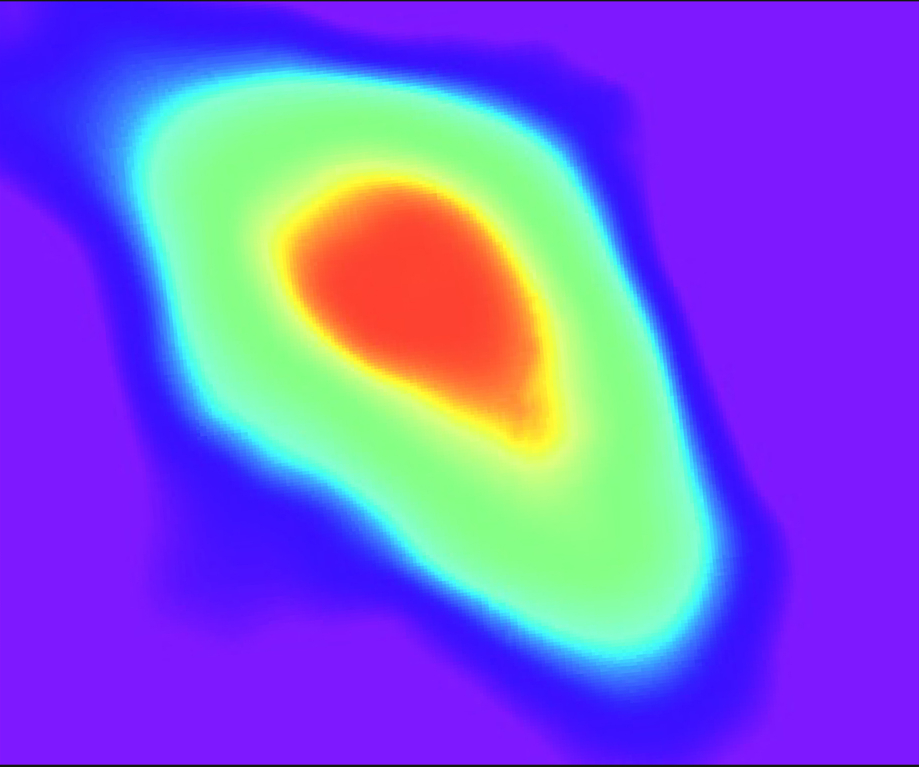Beyond the Visible

Our view of the sky is shaped by what our eyes can detect. Yet there are many wavelengths of light beyond the colors we see. They let us observe star birth and death, peer into the dusty hearts of galaxies, and detect the otherwise invisible effects of black holes.
We can’t tune our eyes to radio, microwave, infrared, ultraviolet, x-ray, or gamma-ray light. But we can extend our vision with detectors sensitive to such wavelengths. These instruments reveal a universe more detailed and understandable than we can see with only visible light




Eye on the Radio Sky
 Radio waves open a window on black holes and jets of superheated gas streaming away from the hidden cores of galaxies. The center of the Milky Way Galaxy, which is hidden from our view by dust clouds, is populated by clusters of young stars, a glowing ring of gas, and a black hole. These all emit a whirlwind of radio waves.
Radio waves open a window on black holes and jets of superheated gas streaming away from the hidden cores of galaxies. The center of the Milky Way Galaxy, which is hidden from our view by dust clouds, is populated by clusters of young stars, a glowing ring of gas, and a black hole. These all emit a whirlwind of radio waves.
Radio Explorations of a Faraway Galaxy
We use radio waves in telecommunications. They carry signals for radio and TV broadcasts, cellular phones and beepers, and other satellite communications. Radio emissions have the longest wavelengths in the spectrum. This enables them to reach Earth’s surface, where we detect them with radio telescopes.
 A familiar galaxy like M81 (left) in Ursa Major looks very different in radio wavelengths. The Very Large Array radio telescopes studied hydrogen clouds in this spiral galaxy.
A familiar galaxy like M81 (left) in Ursa Major looks very different in radio wavelengths. The Very Large Array radio telescopes studied hydrogen clouds in this spiral galaxy.
Hydrogen is an important ingredient needed to form new stars. The bright colors in this image are areas where cold hydrogen gas is plentiful in the spiral arms. These gas-rich regions could become stellar nurseries.
A Warm Microwave Glow
 The microwave universe looks very different from what we see with our eyes. The Milky Way Galaxy appears as a bar of hazy light emitted by warm dust clouds. This dust gives off heat, which our spacecraft detect as microwave radiation. Beyond the galaxy, all of space is permeated by a microwave glow left over from the Big Bang that created the universe.
The microwave universe looks very different from what we see with our eyes. The Milky Way Galaxy appears as a bar of hazy light emitted by warm dust clouds. This dust gives off heat, which our spacecraft detect as microwave radiation. Beyond the galaxy, all of space is permeated by a microwave glow left over from the Big Bang that created the universe.
Microwaves Map the Early Universe
Most microwave light from space passes through Earth’s atmosphere without much interference. Scientists first detected cosmic microwaves from the ground. Astronomers need to use space-based observatories to make the very precise measurements that help map the structure of the early universe.
 The ancient history of the universe is written in a faint glow of cosmic background radiation. This first light emerged from the fog of the Big Bang, more than 13 billion years ago.
The ancient history of the universe is written in a faint glow of cosmic background radiation. This first light emerged from the fog of the Big Bang, more than 13 billion years ago.
The Wilkinson Microwave Anisotropy Probe mapped fluctuations in the temperature of matter in the very early universe. Gravity pulled that matter together, creating the seeds of the galaxy clusters we see today.
Infrared Lifts the Veil
 Everything in the universe radiates heat. We detect it as infrared light. Infrared astronomy lets us peek into hidden nurseries where stars are being born and lifts the veils of dust that keep the hearts of galaxies from our view. Telescopes sensitive to infrared peer into the shrouded core of the Milky Way Galaxy and reveal the swarms of stars clustered there.
Everything in the universe radiates heat. We detect it as infrared light. Infrared astronomy lets us peek into hidden nurseries where stars are being born and lifts the veils of dust that keep the hearts of galaxies from our view. Telescopes sensitive to infrared peer into the shrouded core of the Milky Way Galaxy and reveal the swarms of stars clustered there.
Infrared Stellar Baby Pictures
Infrared radiation from the Sun warms Earth and makes life possible here. This light comes in three wavelength ranges: near, mid, and far infrared. Our atmosphere absorbs infrared, and we cannot detect much of it from the ground. Instead, we use spacecraft to observe it.
 Stellar nurseries are active places, but the clouds of gas and dust that give birth to stars keep us from seeing the action. Infrared light from newly formed objects, however, passes through those clouds.
Stellar nurseries are active places, but the clouds of gas and dust that give birth to stars keep us from seeing the action. Infrared light from newly formed objects, however, passes through those clouds.
The Spitzer Space Telescope focused its infrared-sensitive cameras on NGC1333 (left) in the constellation Perseus. Jets from newborn sun-like stars are sculpting their birth nebula.
The Visible Universe
 Millions of stars arc across our sky and define the visible shape of the Milky Way Galaxy. Yet, there is more to the universe than meets the eye. Even in visible light, there are places we cannot see. Clouds of dust obscure the heart of our galaxy, hiding a supermassive black hole surrounded by a ring of hot gas and clusters of bright stars.
Millions of stars arc across our sky and define the visible shape of the Milky Way Galaxy. Yet, there is more to the universe than meets the eye. Even in visible light, there are places we cannot see. Clouds of dust obscure the heart of our galaxy, hiding a supermassive black hole surrounded by a ring of hot gas and clusters of bright stars.
The Light We See
The visible light we see with our eyes is a fraction of the light in the universe. Most Earth-based telescopes observe primarily in visible-light wavelengths. We also use space-based instruments like the Hubble Space Telescope to rise above Earth’s interfering atmosphere.
 If we could stare into space continuously for ten days, we would see some of the most distant galaxies in the cosmos. This is what the Hubble Space Telescope did in 1996.
If we could stare into space continuously for ten days, we would see some of the most distant galaxies in the cosmos. This is what the Hubble Space Telescope did in 1996.
The resulting visible-light Hubble Deep Field image (left) is stuffed with galaxies. Many are so far away that they appear as they did when the universe was only a billion years old.
Seeing the Ultraviolet
 The ultraviolet view of our galaxy’s center is dark. We know this region has stars, superheated gases, and a black hole, but thick clouds of dust absorb the ultraviolet light they emit. The rest of the ultraviolet universe is easier to detect, but we must use telescopes orbiting above the thick blanket of air that protects Earth from this energetic radiation.
The ultraviolet view of our galaxy’s center is dark. We know this region has stars, superheated gases, and a black hole, but thick clouds of dust absorb the ultraviolet light they emit. The rest of the ultraviolet universe is easier to detect, but we must use telescopes orbiting above the thick blanket of air that protects Earth from this energetic radiation.
An Ultraviolet View of Young Stars
Our eyes can’t see ultraviolet light, but we feel its wavelengths when sunlight burns our skin. Ultraviolet light is very damaging to living cells. Our atmosphere absorbs and blocks most ultraviolet radiation from reaching the surface. This means we study it using space-based instruments.
 Star birth is an energetic activity. It gives off huge amounts of ultraviolet radiation. The Galaxy Evolution Explorer’s image of the neighboring Andromeda Galaxy (left) shows great waves of star formation in its spiral arms.
Star birth is an energetic activity. It gives off huge amounts of ultraviolet radiation. The Galaxy Evolution Explorer’s image of the neighboring Andromeda Galaxy (left) shows great waves of star formation in its spiral arms.
The blue regions here are places where stars are forming. The yellow and orange areas in the bulge are filled with old, cool stars. The red dots are stars in our own galaxy.
Energetic X-Ray Events
 High-energy events shower the universe with x-rays. A solar flare, the interaction of a comet with the solar wind, the birth of a star, a supernova shockwave, and material falling into a black hole are all x-ray emitters. We know that the core of our Milky Way Galaxy is a hotbed of activity because its central black hole is a strong source of x-rays.
High-energy events shower the universe with x-rays. A solar flare, the interaction of a comet with the solar wind, the birth of a star, a supernova shockwave, and material falling into a black hole are all x-ray emitters. We know that the core of our Milky Way Galaxy is a hotbed of activity because its central black hole is a strong source of x-rays.
X-Rays and the High-Energy Universe
X-rays are high-energy, small-wavelength waves of radiation. Since they pass easily through our bodies, we use them for medical diagnoses. They are almost entirely blocked by our atmosphere, which is why we study them with spacecraft.
 When astronomers study a galaxy in turmoil, they always see something fascinating. The Chandra X-ray Observatory studied Centaurus A (left) and found evidence of a huge jet spewing out material from the galactic core, as well as two arcs of x-ray-emitting gas.
When astronomers study a galaxy in turmoil, they always see something fascinating. The Chandra X-ray Observatory studied Centaurus A (left) and found evidence of a huge jet spewing out material from the galactic core, as well as two arcs of x-ray-emitting gas.
This evidence from Centaurus A suggests that a supermassive black hole is stirring up the core of the galaxy.
Gamma-Ray Clues
 The most energetic things in the universe show up in the gamma-ray window. Super-hot, flashy events like galaxy collisions and supernova explosions send out huge bursts of gamma rays. The heart of our own Milky Way Galaxy is a strong gamma-ray source. There, the gravity of its supermassive black hole heats nearby gas being drawn in by the intense gravity.
The most energetic things in the universe show up in the gamma-ray window. Super-hot, flashy events like galaxy collisions and supernova explosions send out huge bursts of gamma rays. The heart of our own Milky Way Galaxy is a strong gamma-ray source. There, the gravity of its supermassive black hole heats nearby gas being drawn in by the intense gravity.
Gamma-Ray Bursts
Gamma rays have the most energy and smallest wavelengths of any form of light in the electromagnetic spectrum. Extremely energetic events generate them. Our atmosphere absorbs incoming gamma rays, so we detect them with observatories in space.
 On January 31, 1993, the Compton Gamma Ray Observatory recorded the “Superbowl Burst,” a flood of gamma rays pouring out from an object in space. This image (left) targets the source’s location near the constellations Virgo and Corvus.
On January 31, 1993, the Compton Gamma Ray Observatory recorded the “Superbowl Burst,” a flood of gamma rays pouring out from an object in space. This image (left) targets the source’s location near the constellations Virgo and Corvus.
Gamma-ray bursts can appear anywhere in the sky and then quickly vanish. Some could be caused by collisions between black holes or by neutron star-black hole mergers.